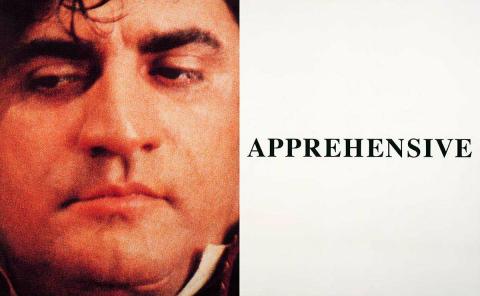BALDESSARI, John; Prima facie (second state): Apprehensive
American artist John Baldessari has said of the series from which Prima Facie (Second State): Apprehensive 2005 is part:
'What I was trying to do was find equivalents - one word that would have the same weight as the photograph. But knowing that, one, I'm using actors and actresses, and what they do is fake emotion, and then trying to figure out if I saw a person with that face that I might think they were angry or suspicious or unpleasant or whatever, but I could be entirely wrong. Who knows? That's why I call it Prima Facie - first sight; that's how we jump to conclusions... The image size and text size are equal. I've always had this idea that a word and an image are interchangeable.'(1)
Typically, Baldessari's works of recent years are deceptively pared-down combinations of images, with and without text. At first glance these works appear to be comparatively simple montages, but an intriguing ambiguity and play between visual and textual language is activated as the codes of those languages are 'read' and interpreted. This potential ambiguity is flagged in the title. The Latin 'prima facie' - on first appearance or at first sight - refers to the initial evidence of that which is seen, as it appears.
Baldessari's photographic fragments are easily recognised as film stills rather than documentary photographs, for example, which inherently suggest a different mode of interpretation. His quoting and manipulation of an established cinematic history through the form of anonymous images confounds a conventional reading of them. As isolated stills, removed from their original narrative context, they become obsolete in one sense, but also available for re-animation in another, often vastly different, scenario.
Baldessari's Prima Facie (Second State): Apprehensive teases the viewer with the question, 'What does being apprehensive actually look like?' But that is only one of the many questions that arise from Baldessari's fluent strategy of montage and juxtaposition. At the most basic level, the work presupposes the expectation that viewers will see the text as a caption to the image - a journalistic convention that has permeated our habits of seeing and reading imagery for over a century. Baldessari's skill at suspending meaning, sabotaging linearity and liberating context-dependent images from their frames of reference has defined him as one of the most influential artists for the current, younger generation of electronic media-based artists.
1. Micel Hebron, Foreword to interview with John Baldessari by Moira Roth, 1973, Xtra Contemporary Art Quarterly, vol.8, issue 2, http://www.x-traonline.org/vol8_2/interview_jb.htm, viewed 17 April 2006.
